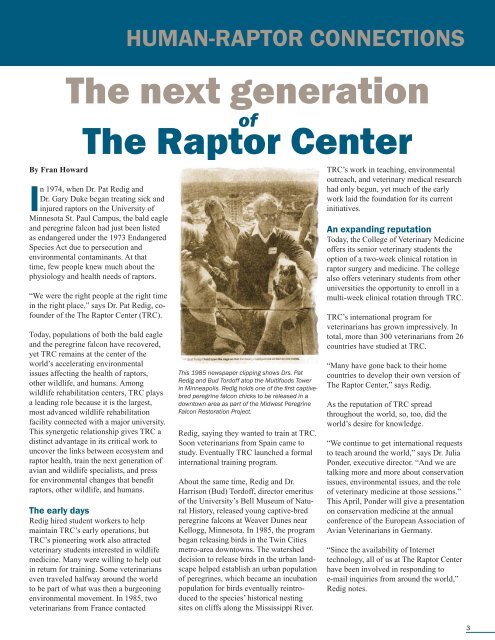Raptor Release-Spring 2013.indd - University of Minnesota College ...
Raptor Release-Spring 2013.indd - University of Minnesota College ...
Raptor Release-Spring 2013.indd - University of Minnesota College ...
- No tags were found...
Create successful ePaper yourself
Turn your PDF publications into a flip-book with our unique Google optimized e-Paper software.
HUMAN-RAPTOR CONNECTIONSThe next generation<strong>of</strong>The <strong>Raptor</strong> CenterBy Fran HowardIn 1974, when Dr. Pat Redig andDr. Gary Duke began treating sick andinjured raptors on the <strong>University</strong> <strong>of</strong><strong>Minnesota</strong> St. Paul Campus, the bald eagleand peregrine falcon had just been listedas endangered under the 1973 EndangeredSpecies Act due to persecution andenvironmental contaminants. At thattime, few people knew much about thephysiology and health needs <strong>of</strong> raptors.“We were the right people at the right timein the right place,” says Dr. Pat Redig, c<strong>of</strong>ounder<strong>of</strong> the The <strong>Raptor</strong> Center (TRC).Today, populations <strong>of</strong> both the bald eagleand the peregrine falcon have recovered,yet TRC remains at the center <strong>of</strong> theworld’s accelerating environmentalissues affecting the health <strong>of</strong> raptors,other wildlife, and humans. Amongwildlife rehabilitation centers, TRC playsa leading role because it is the largest,most advanced wildlife rehabilitationfacility connected with a major university.This synergetic relationship gives TRC adistinct advantage in its critical work touncover the links between ecosystem andraptor health, train the next generation <strong>of</strong>avian and wildlife specialists, and pressfor environmental changes that benefitraptors, other wildlife, and humans.The early daysRedig hired student workers to helpmaintain TRC’s early operations, butTRC’s pioneering work also attractedveterinary students interested in wildlifemedicine. Many were willing to help outin return for training. Some veterinarianseven traveled halfway around the worldto be part <strong>of</strong> what was then a burgeoningenvironmental movement. In 1985, twoveterinarians from France contactedThis 1985 newspaper clipping shows Drs. PatRedig and Bud Tord<strong>of</strong>f atop the Multifoods Towerin Minneapolis. Redig holds one <strong>of</strong> the fi rst captivebredperegrine falcon chicks to be released in adowntown area as part <strong>of</strong> the Midwest PeregrineFalcon Restoration Project.Redig, saying they wanted to train at TRC.Soon veterinarians from Spain came tostudy. Eventually TRC launched a formalinternational training program.About the same time, Redig and Dr.Harrison (Bud) Tord<strong>of</strong>f, director emeritus<strong>of</strong> the <strong>University</strong>’s Bell Museum <strong>of</strong> NaturalHistory, released young captive-bredperegrine falcons at Weaver Dunes nearKellogg, <strong>Minnesota</strong>. In 1985, the programbegan releasing birds in the Twin Citiesmetro-area downtowns. The watersheddecision to release birds in the urban landscapehelped establish an urban population<strong>of</strong> peregrines, which became an incubationpopulation for birds eventually reintroducedto the species’ historical nestingsites on cliffs along the Mississippi River.TRC’s work in teaching, environmentaloutreach, and veterinary medical researchhad only begun, yet much <strong>of</strong> the earlywork laid the foundation for its currentinitiatives.An expanding reputationToday, the <strong>College</strong> <strong>of</strong> Veterinary Medicine<strong>of</strong>fers its senior veterinary students theoption <strong>of</strong> a two-week clinical rotation inraptor surgery and medicine. The collegealso <strong>of</strong>fers veterinary students from otheruniversities the opportunity to enroll in amulti-week clinical rotation through TRC.TRC’s international program forveterinarians has grown impressively. Intotal, more than 300 veterinarians from 26countries have studied at TRC.“Many have gone back to their homecountries to develop their own version <strong>of</strong>The <strong>Raptor</strong> Center,” says Redig.As the reputation <strong>of</strong> TRC spreadthroughout the world, so, too, did theworld’s desire for knowledge.“We continue to get international requeststo teach around the world,” says Dr. JuliaPonder, executive director. “And we aretalking more and more about conservationissues, environmental issues, and the role<strong>of</strong> veterinary medicine at those sessions.”This April, Ponder will give a presentationon conservation medicine at the annualconference <strong>of</strong> the European Association <strong>of</strong>Avian Veterinarians in Germany.“Since the availability <strong>of</strong> Internettechnology, all <strong>of</strong> us at The <strong>Raptor</strong> Centerhave been involved in responding toe-mail inquiries from around the world,”Redig notes.3

















